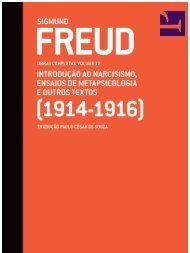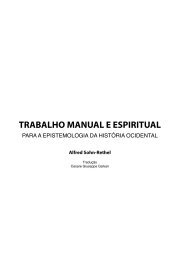Perversion the Social Relation
Perversion the Social Relation
Perversion the Social Relation
- No tags were found...
You also want an ePaper? Increase the reach of your titles
YUMPU automatically turns print PDFs into web optimized ePapers that Google loves.
52 Bruce Finkword is <strong>the</strong> death of <strong>the</strong> thing; <strong>the</strong> thing (<strong>the</strong> "real lack"), once named,comes into being as a word that can be linked up with o<strong>the</strong>r words,joked about, and so on. The word is far less dangerous than <strong>the</strong> thing itsupposedly signifies or designates, for it actually annihilates <strong>the</strong> thing,drains away some of its oppressive force.Once that which <strong>the</strong> mO<strong>the</strong>r is missing is named, <strong>the</strong> object <strong>the</strong> childwas for his mO<strong>the</strong>r can no longer be. For once desire is articulated inwords, it does not sit still, but displaces, drifting metonymically fromone thing to <strong>the</strong> next. Desire is a product of language and cannot besatisfied with an object. The naming of <strong>the</strong> mO<strong>the</strong>r's desire forces <strong>the</strong>child out of his position as object, and propels him into <strong>the</strong> quest for<strong>the</strong> elusive key to her desire. What does she want? Something ineffablethat seems to characterize <strong>the</strong> endless series of things her desire alightsupon—what in Western society is known as <strong>the</strong> phallus. No longer <strong>the</strong>real object (<strong>the</strong> real organ) required to complete her, <strong>the</strong> child can goon to seek to possess what her desire points to, connotes as desirable, asphallic.The mo<strong>the</strong>r's lack has to be named or symbolized for <strong>the</strong> child tocome into being as a full-fledged subject. In perversion, this does notoccur: no signifier is provided that can make that lack come into beingat <strong>the</strong> level of thought, easing its real weight. Nei<strong>the</strong>r <strong>the</strong> mo<strong>the</strong>r nor<strong>the</strong> fa<strong>the</strong>r provides <strong>the</strong> articulation necessary for symbolization. As wesee in Freud's work, <strong>the</strong> question of <strong>the</strong> mO<strong>the</strong>r's lack often centers, inperversion, around <strong>the</strong> mO<strong>the</strong>r's genitalia, her sexual difference fromher son.There are two moments of <strong>the</strong> paternal metaphor. This naming of <strong>the</strong>mO<strong>the</strong>r's desire/lack is <strong>the</strong> second (logical) moment. If <strong>the</strong> first momentof <strong>the</strong> paternal metaphor is <strong>the</strong> fa<strong>the</strong>r's prohibition of <strong>the</strong> child's pleasurablecontact with its mo<strong>the</strong>r (prohibition of jouissance), le Nom duPère taking <strong>the</strong> form of <strong>the</strong> fa<strong>the</strong>r's "No!," <strong>the</strong> second moment involves<strong>the</strong> symbolization of <strong>the</strong> mO<strong>the</strong>r's lack—that is, its constitution as lackdue to <strong>the</strong> fact that it is given a name (here we see le Nom du Père as<strong>the</strong> name provided by <strong>the</strong> fa<strong>the</strong>r, or <strong>the</strong> fa<strong>the</strong>r himself as <strong>the</strong> name of <strong>the</strong>mO<strong>the</strong>r's desire).The two substitutive moments can be represented schematically asfollows:








